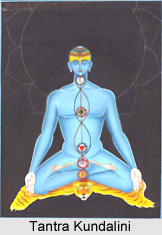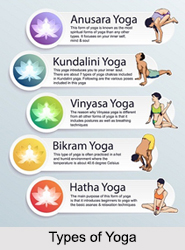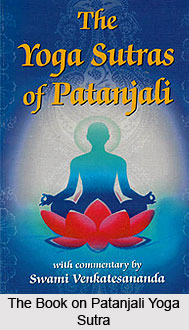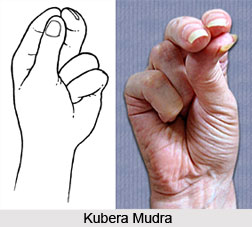 Breathing is indeed one of the elementary bases in releasing the Kundalini. There are many variances of breathing exercises, depending on the function. The following are a few of the possibilities. It is advised to be careful, because more advanced breathing techniques may release Kundalini in uncontrollable ways.
Breathing is indeed one of the elementary bases in releasing the Kundalini. There are many variances of breathing exercises, depending on the function. The following are a few of the possibilities. It is advised to be careful, because more advanced breathing techniques may release Kundalini in uncontrollable ways.
Colour Breathing- One needs to sit or lie comfortably, making sure that the spine is upright. Firstly, one should begin to breathe into the entire body, feeling the breath enter each cell, then one should imagine that the body is filled with a red light (one needs to make it a red "with love" so it does not bring up old frustrations). This state should be held on for a few minutes, breathing into each cell, conscious of the vibrational quality within the system. Then one can release the red light and do the similar with orange, yellow, green, blue, purple and lavender (in that order). Eventually, one needs to fill the body with a radiant white light and meditate on the divine source. (The meditation can be diverged by centering on God, a spiritual being, the universe, the purpose of life or a spiritual verse or idea.) After completing the exercise, one should stretch the whole body.
Vibrational Breathing- Firstly, one should sit upright or lie contentedly, with the spine erect. Then, one should start breathing deeply, allowing the whole body and abdominal regions to project out. Firstly, one needs to fill the lower part of the chest with air, extending the abdomen slightly, then expanding the middle of the chest and finally the upper part of the chest. Then, one needs to inhale for seven counts; hold on for seven counts, exhale to the count of seven, and hold the breath out for seven counts. Then, it needs to be continued. One can synchronise the counting with the pulse beat; speed doesn`t matter as much as evenness and continuity.
If the chest scarcely moves during inhalation or exhalation, one can try consciously fighting it out while inhaling and pulling it in while exhaling. Many a person`s rib cage are so locked in by their muscle system, that it is complicated for them to take a good breath. As the rhythm gets rolling and the counting becomes automatic, one should become attentive of the pulse of the universe- it`s in and out movement- and its vibrational hum. One can also follow this exercise with open meditation.
Freeing Breathing- One needs to take deep, calm breathes. Then, one must concentrate on the breath leaving the toes, then the fingers, finally the top of the head. One needs to picturise or imagine the breath taking the anxieties of life with it as it leaves these areas.

This is a brilliant exercise for equalising the energy in the body and thereby relaxing the system. It brings a refreshed feeling, particularly when followed by at least five to ten minutes of rest.
Complete Breathing- This process is called complete breathing, because when done appropriately, the breathing cycle fills the whole system. At first, one needs to practice it lying down. He or she can bend the knees so that the feet are flat on the floor; then, one must place the hands- fingertips hardly touching- on the belly below the navel. After inhalation, one needs to separate the fingers slightly. After gaining some skills, one can try this breathing process sitting up, then in a standing position. It should eventually become the normal way to breathe. There are six steps-
1. To fill the lower part of the lungs, allowing the diaphragm to stretch and the abdominal wall to expand.
2. To fill the middle of the lung area, allowing the rib cage to stretch.
3. To fill the top of the lungs, allowing the upper chest to stretch and the abdominal wall to withdraw. Pulling the abdominal wall back in allows the top of the lungs to fill more completely. (It is advised to perform the above three steps in one continuous movement using six pulse beats).
4. One needs to hold the breath back for a few seconds, allowing the chest and belly to relax more fully.
5. One needs to exhale slowly and evenly, pulling and lifting the abdomen, allowing the chest to constrict, then, it needs to repeated using six pulse beats.
6. He or she needs to allow the chest and abdominal areas to relax and be still for a few seconds before beginning the process all over again. However, one needs to be sure that the back is relaxed.
But, it is needed to make sure that during standing or sitting, the chest is pretty upright` slouching will not allow the lungs to fill appropriately. This is not easy at first; it shall take practice and patience. Two or three absolute breathes are enough in the beginning. Progressively, one can increase the number until ten full total breathes can be done with no pains.
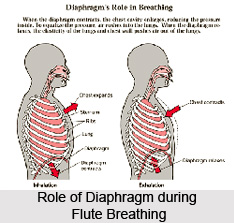
Cleansing Breathing- Firstly, one needs to perform three whole breathes, holding the breath for several seconds on the third complete breath. Secondly, holding the cheeks strongly, one will need to gather the lips and push breath out in short blasts, holding briefly in between each blast. This process needs to be continued, until all air is expelled. The force of each `blast` helps purify the system and invigorate it. This process needs to be repeated, taking only one absolute breath for each exhalation.
Flute Breathing- One needs to perform the above exercise, but on the exhalation, he or she must hold the lips, as if playing a flute or blowing a bottle top. It is advised to keep the exhalation in one continuous stream, until all air is expelled. This releases surplus energy.





